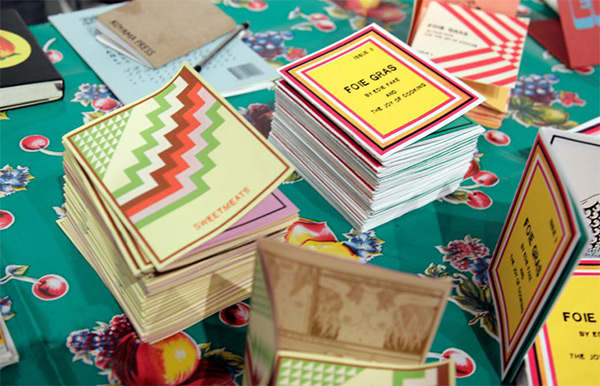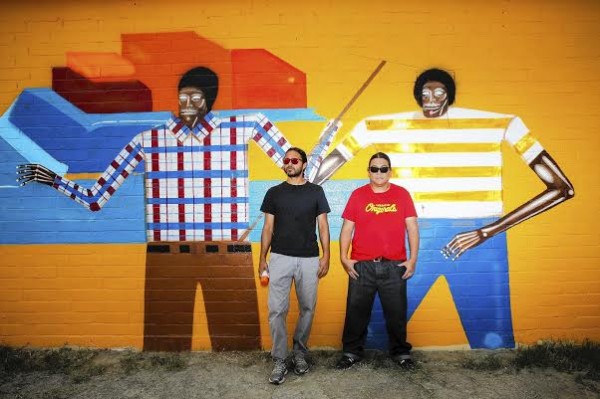DTLA—The glass door at 410 Spring Street is cracked open, just enough to hear the faint sound of electronic music and smell fresh sawdust. Inside the gallery, a young man sweeps the floor as others hustle to move scraps of wood from one area to another. The eye is drawn to the center of the space at what looks to be an actual, albeit condensed, Indian temple with columns and a bulbous roof that touches the ceiling.
“I don’t want to ruin too much but for the last month we’ve been here building a temple,” says Unga, founding member of Broken Fingaz, a graffiti crew based in Haifa, Israel. On Saturday, June 20, 2015, Howard Griffin Gallery Los Angeles will present Journey Galactiko, the BFC’s debut show in the US.
“For this show, we just felt for such a long time we want to do something in America and specifically [Los Angeles],” says Unga, taking a seat on the steps of the unfinished 150-square-meter indoor temple, the show’s centerpiece, “So we just waited for the chance… and then when the offer came we were just like, fuck yeah we’re going to go for it.”
Before touching down at LAX, the BFC spent two months in India working with LA in mind. The idea was to “be disconnected from everything” with a focus on “just creating” works. They are coming to the table with seventeen paintings completed while in India, all acrylic on paper, a step, or two, away from their graffiti roots but still within earshot.
“We met in High School, me and Kip, and we started as a graffiti crew with the older guys,” says Unga, speaking of the BFC’s beginnings. One of those older graffiti artists, known as Crazy Bob, was the first graffiti writer in Haifa and among the first in Israel. He took time to mentor the graffiti novices, “In Haifa 2001, there wasn’t graffiti so we didn’t know what to do,” says Unga, “He got us into the culture,” by first seeing their tags around the city and teaching them everything he knew. “For writers coming to Haifa, this is the man who takes care of them,” Tant chimes in.
When the older graffiti artists, known as NRC, were conscripted into the IDF in 2001, seventeen-year-old Unga and Kip stayed behind and started the BFC, and a few years later added Tant and Deso to the main roster. “At first it was graffiti, then we started doing more designs,” says Unga, “This is how we first became known in Israel, it wasn’t for graffiti it was more we did art for parties, punk shows, stuff like this.”
The first-generation graffiti crew later established an art scene in Haifa by founding Kartel in 2014, an arts venue in the city’s downtown area, where they organize exhibitions, shows and parties for themselves and friends. Otherwise, there is no gathering place for artists in Haifa, “I don’t even think there’s one gallery,” Deso says.
From their musings of this place all four call home, Haifa sounds desolate and rather dreamy. “It’s really a ghost town,” says Tant. The city feels empty with abandoned neighborhoods of sturdy, old stone buildings that have been left alone for years and a landscape surrounded on one side by mountains and the other by the Mediterranean Sea. Haifa is a working-class port city where Arabs and Jews coexist in relative peace. “I cannot be proud and say yeah I’m Israeli, but I can say I’m from Haifa and know what it represents, first of all, because it’s not political and it’s more about the people, the landscape, that kind of stuff,” says Unga.
The crew credits Haifa for its ability to foster quality over quantity, as Deso puts it, “There’s really few people doing [graffiti] in Haifa, really few.” This gives them the freedom to create without precedent, one benefit of living in a small city, but the work must maintain a certain quality to garner respect, “So, in this sense, it pushes you,” says Unga, “But at the same time, it doesn’t put you in this box where you have to do this or that, you have to work your way up.”
Haifa has become a second stop for artists and musicians who travel to Tel Aviv, Israel’s decided cultural epicenter, but still the BFC are big fish in a small pond, having already shown their work at Israel’s most prestigious arts institutions in Tel Aviv and Haifa, and abroad in London and Beijing, among other venues.
Broken Fingaz rejects labeling their work as street art, and self-identify as “graffiti gypsies,” who maintain an ever-present graffiti approach with their paintings. “The Gypsy Movement,” Unga calls it.
Skateboards lean up against the gallery’s subway-tiled wall near a temporary workspace. “So much of the culture that we like comes from [LA],” says Unga, “Skateboard art affected all of us and probably was the first thing that made us want to do this even before graffiti and a lot of it came from here: surfing, punk, hip hop—everything.”
They’re finding LA to be comfortable; Tant agrees: “I love the weather, I love the Mexican food, Mexican people I love also.” Everyone but Unga is visiting LA for the first time and consider it “cool” but flawed; spending much of their time Downtown means confronting the city’s pervasive homeless population, as Skid Row bursts at the seams. “It’s unbelievable,” says Unga, “We came to the downtown and it’s like, whoa there’s more homeless [in LA]
than in India.”
The BFC is hoping to land a mural commission in LA before moving on with their travels—a road trip up Calif. then Amsterdam—and continue to design art for some of LA’s finest beatmakers like DJ Quik, Alchemist and Gaslamp Killer, who will perform at the opening.
Unga’s last words for the potential Journey Galactiko attendee: “If you like yourself the way you are, don’t come,” as the rest of the BFC snickers.
Journey Galactiko is running from June 20 to August 2 at the Howard Griffin Gallery, 410 South Spring Street, Los Angeles CA 90013 (Weds-Sun, Noon-8pm). Opening is free and open to public, begins at 7pm.
Images provided courtesy of the artist. Lauren McQuade is a freelance journalist based in Los Angeles, find her work here.












